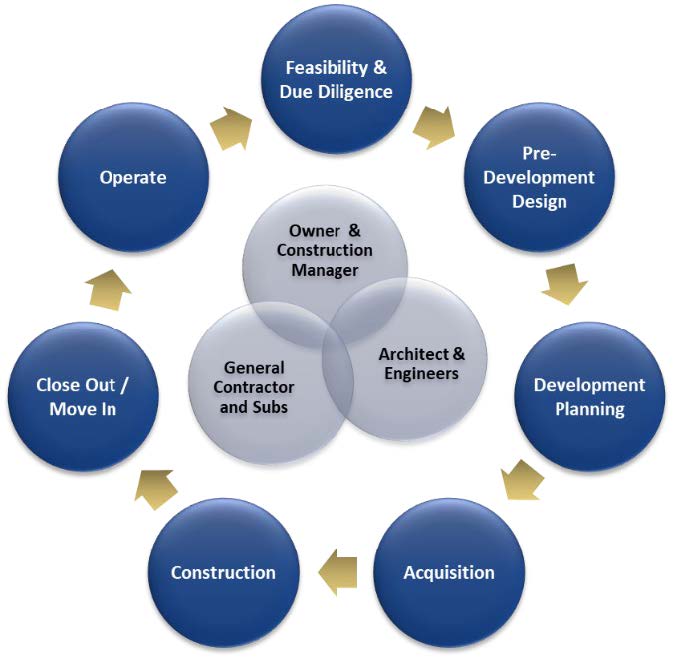Below you will find resources specific to Real Estate development planning. This page will grow as new resources for applicants and grantees are added.
The Lien Waiver and Proof of Payment webinar, presented August 1, 2024, provides detailed information about the requirements for a complete BHCIP draw request package, with a specific focus on lien waivers and proof of payment.
The End of Construction webinar, held September 17, 2024, focuses on BHCIP program requirements and real estate development best practices relating to the end of construction, including the closeout timeline, as well as PFA Article 4.3 compliance requirements and final certifications.
During the first phase of real estate development, you will identify the facility’s big-picture needs, such as the goals that will be achieved by building the structure and the people and businesses that will benefit from it when finished, determine the costs and potential barriers, and identify solutions to bring your vision to life.

Obtain the supplemental guide and other information in the resources linked below.
In A Guide to Successful Siting Strategies: Ensuring Delivery of Mental Health Services and Supportive Housing in Community Settings, the County of Los Angeles Department of Mental Health provides helpful information on identifying and building relationships with stakeholders.
The U.S. Small Business Administration’s Write Your Business Plan webpage provides helpful information and templates
Learn more about the differences in responsibility between the architect and construction manager in this infographic, Architecture & Construction Management: From the Ground Up, produced by the New School of Architecture and Design.
In Establishing Site Control, the Corporation for Supportive Housing provides a brief overview of the different forms of site control and negotiating a purchase agreement.
In Phase 2, you will bring the work completed in Phase 1 to life in schematic drawings (SDs). Generally, you will be laying groundwork and developing your overall approach to the project. This phase includes financial planning activities, obtaining initial approval of your building plans, and ongoing stakeholder relationship-building to create excitement and support for your project.

Obtain the supplemental guide and other information in the resources linked below.
Resources for understanding and implementing CEQA are available at the Governor’s Office of Planning and Research website.
The California Department of Industrial Relations publishes information on prevailing wage requirements.
The AIA Schematic Design Checklist is produced by the American Institute of Architects (AIA).
The most important thing you can do to get started is to learn who you need, how you find them, and when to hire them! The Guide to Building Your Real Estate Development Team, available in the Related Resources section, provides additional details.

Obtain the supplemental guide and other information in the resources linked below.
Construction Project Team: Roles and Responsibilities of 9 Key Positions explores typical construction project team roles and responsibilities that are found on successful projects, as well as required experience levels.
Obtain the supplemental guide and other information in the resources linked below.
Commercial Real Estate Terms and Definitions, NAIOP
Web version: The Commercial Real Estate Development Association (NAIOP) maintains a web-based list of industry definitions here: Commercial Real Estate Industry Terms and Definitions
Download: Download the pdf: CRE Terms and Definitions 2017
Development Process
In this blog post and tool, Groundworks USA discusses the complexities of the development process and presents a Development Process Map in four different formats: New Interactive Tool Helps Communities Navigate the Real Estate Development Process
Breaking Ground: A Comprehensive Planning Guide for Health Center Projects: The Annie E. Casey Foundation and NCB Development Corporation collaborated on this manual to help health center managers navigate the development of a health center facilities project: Download the pdf: Breaking Ground- A Comprehensive Planning Guide
Planning a Real Estate Project
Michael McCormick’s Planning a Real Estate Project is designed to both assist organizations with defining the needs of spaces and determine whether those organizations are well poised to undertake a real estate development or relocation project.
How to engage, communicate with, and include the community in the development of new behavioral health and housing infrastructure. The following videos offer a thoughtful discussion of how to practice being a good neighbor, additional resources are available in the Related Resources Section.
Access helpful related resources linked below.
Read the Advocates’ Guide to Housing & Community Development Policy released by the National Low Income Housing Coalition.
This document gives examples of a wide variety of materials and outreach tools groups have used in the Bay Area to inform
communities about affordable housing. Read Examples of Materials and Outreach Strategies Used in Housing Education Campaigns.
This PDF, released by the California Department of Housing and Community Development, gives suggestions gleaned from organizers of recent housing tours on how to make the most of them. Read How to Organize Successful Affordable Housing Tours
This PDF, released by the California Department of Housing and Community Development, is a partial listing of some of the campaigns conducted by local groups. Read Education/Advocacy Campaigns on Affordable Housing in the Bay Area.
Read Speakers Bureau Dos and Don’ts, released by the California Department of Housing and Community Development.
Read What Works in Affordable Housing Education? This PDF was released by the California Department of Housing and Community Development.
Read Parking Requirements Guide for Affordable Housing Developers, released by Southern California Association of Non-Profit Housing.
The purpose of this Catalog is to assist organizations in replicating the successful public education efforts conducted by the many community development corporations, local housing coalitions and providers of affordable housing across the nation. Read the Housing Advocacy Catalog.
This toolkit, released by the Washington State Department, was developed as a communications resource to support jurisdictions, providers, and others in siting community-based behavioral health facilities. Read the Behavioral Health Project Communication Toolkit